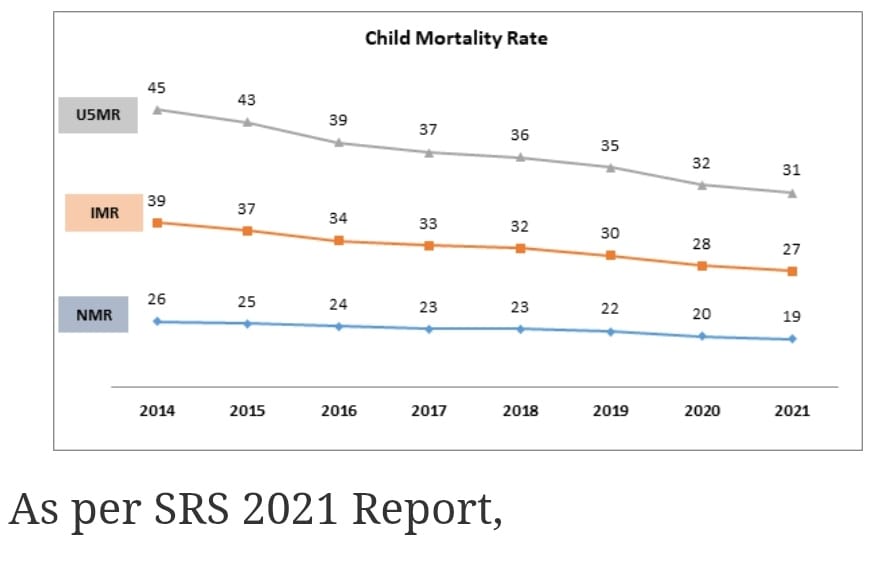~India’s Progress Outpaces Global Averages
~Maternal Mortality Ratio drops significantly from 130 to 93 per lakh live births
~Infant Mortality Rate declined from 39 per 1000 live births in 2014 to 27 per 1000 live births in 2021
~Neonatal Mortality Rate falls from 26 per 1000 live births in 2014 to 19 per 1000 live births in 2021
~Under-Five Mortality Rate has dropped from 45 per 1000 live births in 2014 to 31 per 1000 live births in 2021
~Fertility Rate is consistent at 2.0 in 2021
~Sex Ratio at Birth improves from 899 to 913
New Delhi, May 10, As per the Sample Registration System (SRS) Report 2021 released by the Registrar General of India (RGI), on 07th May, 2025, India has continued to witness a significant improvement in key maternal and child health indicators.
As per the Special Bulletin on Maternal Mortality in India, 2019-21 based on the Sample Registration System (SRS), the Maternal Mortality Ratio (MMR) of the country has shown a marked reduction, declining by 37 points from 130 per lakh live births in 2014–16 to 93 in 2019–21.
- Eight (8) States have already attained SDG target of MMR (<=70 by 2030): Kerala (20), Maharashtra (38), Telangana (45), Andhra Pradesh (46), Tamil Nadu (49), Jharkhand (51), Gujarat (53), Karnataka (63).
- Twelve (12) States/UT have already attained SDG target of U5MR (<=25 by 2030): Kerala (8), Delhi (14), Tamil Nadu (14), Jammu & Kashmir (16), Maharashtra (16), West Bengal (20), Karnataka (21), Punjab (22), Telangana (22), Himachal Pradesh (23), Andhra Pradesh (24) and Gujarat (24).
- Six (6) States/ UT have already attained SDG target of NMR (<=12 by 2030): Kerala (4), Delhi (8), Tamil Nadu (9), Maharashtra (11), Jammu & Kashmir (12) and Himachal Pradesh (12).
Further, India’s Progress in reduction of Maternal and Child mortality indicators outpaces Global Averages.
As per the current United Nation Maternal Mortality Estimation Inter-agency Group (UN-MMEIG) Report 2000-2023, published on 07 April 2025, India’s MMR has reduced by 23 points from 2020 to 2023. By this achievement, MMR of India has now declined by 86% compared to global reduction of 48% over the past 33 years from 1990 to 2023.
Significant achievement has been highlighted in reduction of Child Mortality in India in the United Nations Inter-agency Group for Child Mortality Estimation (UN IGME) Report 2024, published on 24 March, 2025. India is among the top performer countries with reduction in Child Mortality Rates. As per the Report, India achieved a 78% decline in the Under-Five Mortality Rate (U5MR) surpassing the global reduction of 61%; 70% decline in the Neonatal Mortality Rate (NMR) compared to 54% globally, and 71% decline in the Infant Mortality Rate (IMR) compared to 58% globally, over the past 33 years from 1990 to 2023.
These sustained improvements are a result of strategic interventions and unwavering commitment of the Government of India.
The Government’s flagship health schemes are seamlessly integrated to guarantee dignified, respectful, and high-quality healthcare services—completely free of cost, with zero tolerance for denial of care. Ayushman Bharat, the world’s largest health assurance initiative, provides an annual health coverage of up to ₹5 lakh per family, ensuring financial protection and access to essential services.
Focused interventions ensure that every pregnant woman is entitled to free institutional delivery, including caesarean sections, along with complimentary transport, medication, diagnostics, and nutrition support in public health facilities. To ensure inclusive and equitable access, the Ministry has significantly strengthened health infrastructure by establishing Maternity Waiting Homes, Maternal and Child Health (MCH) Wings, Obstetric High Dependency Units (HDUs)/Intensive Care Units (ICUs) Newborn Stabilization Units (NBSUs), Sick Newborn Care Units (SNCUs), Mother-Newborn Care Units, and dedicated programs for the screening of birth defects.
Key clinical practices such as the administration of antenatal corticosteroids for preterm labor, use of Continuous Positive Airway Pressure (CPAP), and structured follow-up for hearing and vision screening contribute to improved newborn survival outcomes. These measures support approximately 300 lakh safe pregnancies and 260 lakh healthy live births annually.
A core priority is ensuring that quality healthcare services reach every corner of the country. This is being addressed through facility-based quality certification, enhancement of healthcare workers’ skills, and robust supervisory mechanisms. Special emphasis is placed on training and deploying skilled birth attendants, midwives, and community health workers to deliver essential maternal and child health services.
The Ministry is also reinforcing health data systems and real-time surveillance for maternal, newborn, and child health through digital platforms, thereby facilitating data-driven, evidence-based policy decisions.


